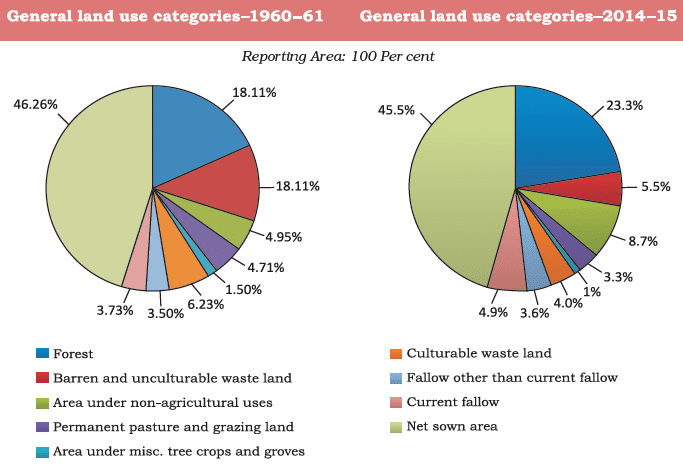In this article, You will read Changes in Pattern of land use in India – UPSC IAS Exam.
Changes in Pattern of Land Use
The land is a crucial natural resource and an important determinant of the socio-economical health of a country.
In India, on the basis of land use pattern, the area of the country was divided into the following five categories in 1950-51.
- Forest
- Land not available for cultivation
- Land put to non-agricultural uses, and
- Barren and Uncultivated land.
- Other uncultivated lands excluding fallow lands
- Permanent pastures and other grazing lands,
- Miscellaneous trees and groves not included in the net area sown.
- Fallow land-Old fallow and Current fallow.
- Net sown area.
The agricultural land use has also recorded some substantial changes in the cropping pattern. The area under wheat and rice has increased at the cost of pulses, millets, and fodder while the area under oilseeds, sugarcane, vegetables, and orchards has increased.
Unfortunately, about 70% of the good quality agricultural land has gone out of agriculture (Urbanisation, industrialization, and development of roads and railways, etc.) and the former fallow land, pastures, and degraded forests areas have been brought under agriculture.
Facts and data analysis
There are significant spatial and temporal changes in the patterns of land use in India. The radical changes in land use have occurred all over the country, but the changes in agricultural land use are substantial in the areas of the green revolution.

Land-use change represents almost 25% of total global emissions. It can be a factor in CO2 (carbon dioxide) atmospheric concentration and is thus a contributor to global climate change.
Land degradation is affecting 3.2 billion people worldwide – Ecosystem services e.g. forest, agriculture, grassland tourism, etc. worth $10.6 trillion are lost due to land degradation annually.
A report analysis done by the Food and Agriculture Organization of the United Nations, states that by 2050, over 500 million hectares area of new agricultural land will be needed to meet the global food demand.
According to the Intergovernmental Platform on Biodiversity and Ecosystem Services (IPBES), over 70% of all-natural, ice-free land in the world is affected by human use and this could further rise to 90% by 2050.
Reasons
- Population Growth – In India, the rapidly growing population and the consequent high pressure on the existing resources have an adverse effect on the land resources. The cities are expanding and getting urbanized far beyond their formal limits.
- Land Encroachment and extensive use of forest resources –
- An increase in food and shelter demands have resulted in expansion by
encroaching the uncultivated land areas and forest, shrubs, and wetlands. - The IPCC report on climate change and land has stated that agricultural land
for food, Animal feed and fiber are behind the land-use change.
- An increase in food and shelter demands have resulted in expansion by
- Over Grazing – The farmers are abandoning their cultivated land for grazing
purposes due to decline in its soil fertility status.
Thus, we can conclude that there are two types of land-use change – one is direct anthropogenic and the other is indirect changes.
- Examples of anthropogenic changes include deforestation, reforestation and afforestation, agriculture, and urbanization, while the indirect changes include climate change or change in CO2 concentration that leads to change in vegetation and land use pattern.
Solutions / way forward
- Smart Forest and Land Management – The improved cropland management, livestock management, agroforestry, and reduced post-harvest losses will help in land restoration. Also, an improvement in land grazing by animals and forest fire management is required.
- Responsible Land Governance – It is the key for better land–use adaptation and for improving the livelihoods of many small-scale farmers. It will also enable ecosystem restoration and biodiversity protection.
- India is a member of UNCCD, and being a party of this agreement, India has the opportunity to adopt an ambitious resolution on land use pattern change and landholdings.
- There is an urgency to slow down and reverse the land-use change. The land-use sector is critical to achieving the aim of the Pris Agreement to limit global warming to 2°C.
WHAT IS UNCCD?
- Established in 1994, the United Nations Convention to Combat Desertification (UNCCD) is the sole legally binding international agreement linking environment and development to sustainable land management.
- Focus Areas: The Convention addresses specifically the arid, semiarid, and dry sub-humid areas, known as the drylands, where some of the most vulnerable ecosystems and peoples can be found.
- From India, the Ministry of Environment, Forest, and Climate Change is the nodal Ministry for this Convention.

Great work. Even though I’m a Sociology optional student, I found your write-ups pretty lucid and to the point. Keep it up.
Thanks Arushi, Keep reading.
Sir every topic is greatly helping me in my geography optional. All I can say is thanks A lot from bottom of my heart.keep up the good work;)